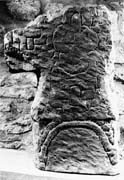Select a site alphabetically from the choices shown in the box below. Alternatively, browse sculptural examples using the Forward/Back buttons.
Chapters for this volume, along with copies of original in-text images, are available here.
Object type: Cross-shaft and part of -head [1]
Measurements: H. 70.5 cm (27.75 in); W. (shaft) 34.3 cm (13.5 in) (head) 42.2 cm (16.6 in); D. 21.5 > 20 cm (8.5 > 8 in)
Stone type: Medium- to coarse-grained (with subangular grains and calcareous cement, but no mica), white (10YR 8/2) sandstone; perhaps Middle Calcereous Grit, Coralline Oolite Formation, Middle Oxfordian, Upper Jurassic; perhaps some immediate vicinity (exposure within 1km of church)
Plate numbers in printed volume: 548-551
Corpus volume reference: Vol 3 p. 160-161
(There may be more views or larger images available for this item. Click on the thumbnail image to view.)
A (broad): The cross-head has a splayed foot (perhaps type 6), but the rest is so fragmentary that it is difficult to attribute a type. In its centre is a large buckle knot consisting of a cross interlaced with closed circuit loops. A smaller version occupied each cross-arm. On the shaft, the slight remains of a broad, plain edge moulding are roughly cut. At its top is an arched moulding with some modelling. There may have been fillers in the spandrels but they are broken.
B (narrow): The cross-arm is lost but it is plain that the cross-head was stepped out from the shaft. The side is scabbled but part of an filler lies at the top within the plain arched moulding.
C (broad): Scabbled, though there are the remains of a domed central boss, and of a plain, flat, arched moulding at the top of the shaft.
D (narrow): Roughly hacked, though a plain arched moulding survives within the edge moulding at the top of the shaft.
This is closely related to no. 4 in its use of discrete buckle knots. The quality of the carving is poor and the ornament unadventurous, so it does not follow that the motifs are chronologically late: simply rustic. There is a local parallel for the buckle-knot at Pickering (no. 3; Ill. 759) and the girdle of the figure at Daglingworth, Gloucestershire is not far distant (Clapham 1930, 140). The free-armed type of cross coexisted with the ring-heads in Ryedale in the tenth century: see Middleton, nos. 1–3, for example.



